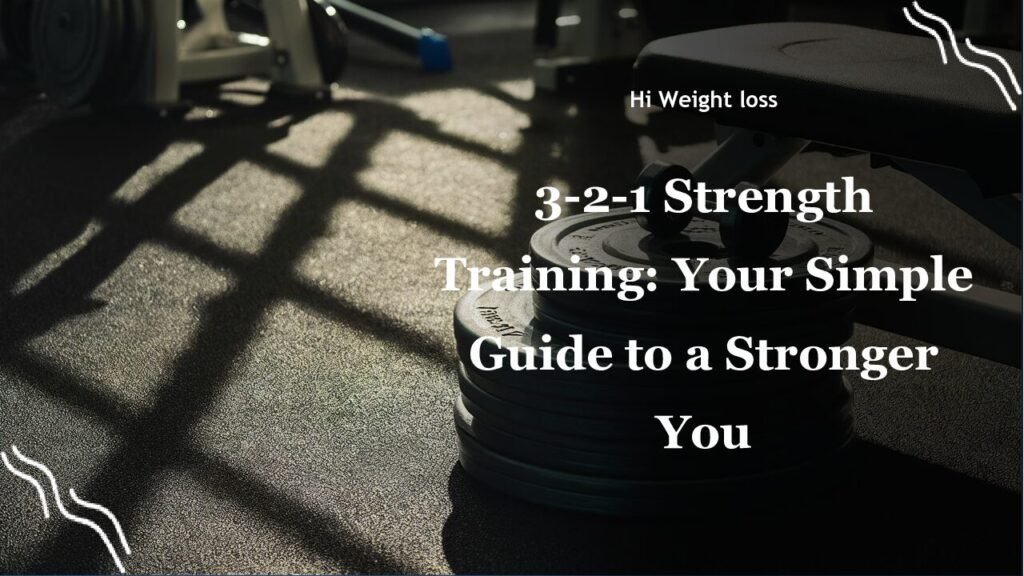“`
Feeling lost in the world of fitness routines, unsure where to start to build strength effectively? It’s a common struggle, and many find themselves overwhelmed by endless workout options and conflicting advice; this can feel incredibly frustrating when you just want a clear path to a stronger, healthier you. This article will explore the 3-2-1 method strength training component, offering a structured approach to help you achieve your fitness goals, and we’ll delve into the ‘what’, ‘why’, and ‘how’ of this versatile method.
Understanding the 3-2-1 Method Strength Training
The 3-2-1 method is a structured workout approach that combines different types of exercise throughout the week. It gets its name from the number of days dedicated to each type of workout: three days of strength training, two days of Pilates or active stretching, and one day of cardio. This balanced approach is designed to promote not just strength, but overall fitness.
When I first heard about the 3-2-1 method, I was intrigued by its simplicity. It seemed like the perfect recipe for a balanced routine, not overly specialized in one area, but also not lacking in a well roundedness. I had previously struggled with sticking to a routine. It was either too hard on my body, or didn’t offer enough variety. The 3-2-1 method promised a sustainable routine that wouldn’t lead to burnout, and I was all in to test it.
The Core of the 3-2-1 Method: Three Days of Strength Training
The heart of the 3-2-1 method revolves around the three days dedicated to strength training. This component is crucial for building muscle mass, improving bone density, and boosting your metabolism. These benefits are not just for bodybuilders; they are essential for general health and well-being. As a fitness expert notes, strength training is essential for long-term health.

The beauty of these three days lies in their flexibility. You can divide your workouts into upper-body, lower-body, and full-body routines. For instance, you might dedicate one day to focusing on your chest, shoulders, and arms, another to your legs and glutes, and the third to a full-body workout incorporating a variety of compound exercises. Some people even prefer doing three full-body sessions, hitting all the major muscle groups multiple times in a week. The key is to ensure you’re hitting all major muscle groups throughout the three sessions and that you’re allowing adequate recovery time.
Benefits of the 3-2-1 Method Strength Training
The benefits of the 3-2-1 method are numerous and far-reaching. Beyond the obvious muscle gain and improved definition, strength training increases your basal metabolic rate, meaning you burn more calories even at rest. It also significantly enhances bone density, reducing the risk of osteoporosis. Studies support how incorporating strength training significantly improves bone health. I also noticed a marked improvement in my daily energy levels. Even on days I wasn’t hitting the gym, I felt more active and less fatigued.
Enhanced Muscle Strength and Definition
By consistently engaging in strength training, you’ll start noticing significant improvements in your muscular strength and overall definition. The targeted workouts ensure that all major muscle groups are worked, leading to a more sculpted and toned physique.
Increased Bone Density
Strength training is a powerful tool for improving bone density, an important factor especially as you age. Stronger bones reduce the risk of fractures and osteoporosis, promoting better health and mobility in the long run.
Improved Basal Metabolic Rate
Muscle is more metabolically active than fat. The more muscle you have, the more calories you burn at rest. This means that incorporating strength training can boost your metabolism, helping you manage your weight more effectively.
How to Incorporate the 3-2-1 Method Strength Training Into Your Routine
Integrating the 3-2-1 method into your fitness routine can be straightforward and flexible. Here’s how you can get started, but don’t be afraid to experiment and find what works best for your body and schedule. I’ve found that planning my workouts on a Sunday makes the routine a lot easier for me to manage throughout the week.
Planning Your Strength Training Days
Start by planning your three strength training days. You can choose any three days of the week that best suit your schedule. Whether you prefer splitting them into an upper/lower/full body routine or want to do three full body sessions, you have room to maneuver. For example, you could do strength training on Monday, Wednesday, and Friday; then, Pilates on Tuesday and Thursday, and cardio on Saturday. I would advise to factor in at least one rest day.
Choosing Your Strength Training Exercises
Your choice of exercises should be diverse to ensure that all major muscle groups are targeted. Here are some examples of exercises you can include:
- Upper Body: Bench press, shoulder press, bicep curls, triceps extensions
- Lower Body: Squats, lunges, deadlifts, hamstring curls
- Full Body: Pull-ups, rows, push-ups
Sample Weekly Schedule
Here’s a sample weekly schedule that incorporates the 3-2-1 method, which can be tailored to suit your needs. Remember, you may need to take an extra rest day if your body is tired. It’s always better to listen to your body.
| Day | Activity |
|---|---|
| Monday | Strength Training (Upper Body) |
| Tuesday | Pilates |
| Wednesday | Strength Training (Lower Body) |
| Thursday | Pilates |
| Friday | Strength Training (Full Body) |
| Saturday | Cardio |
| Sunday | Rest |
This example schedule is just a starting point; feel free to adjust it to fit your personal needs and preferences.
Conclusion
The 3-2-1 method offers a balanced and adaptable approach to fitness, especially with its strength training component. By incorporating three days of structured strength training into your routine, you can experience a variety of benefits from muscle growth to improved bone density and an increased metabolic rate. This method is praised for its flexibility; it allows you to customize your workouts to fit your preferences and physical condition.
Remember my initial apprehension at starting a new routine? I found that the 3-2-1 method made fitness feel a lot less daunting, and even though I felt sore at first, it quickly made my body feel stronger and more resilient. If you’re looking for a method to boost your overall well-being and fitness, consider giving the 3-2-1 method a try. It’s a well-rounded approach that’s easy to integrate into your daily life. Don’t just take my word for it; try it out, and share your experiences with others. If you are ready for a change, make it today!
FAQ
Is the 3-2-1 method suitable for beginners?
Absolutely! The 3-2-1 method is flexible and adaptable, making it great for beginners. Start with lighter weights and focus on mastering the correct form. As fitness experts have discussed, it’s crucial to focus on proper technique, especially when starting.
Can I do the strength training days on consecutive days?
While you can, it’s generally recommended to have at least one day of rest or active recovery between strength training sessions to allow your muscles to recover. This reduces the risk of overtraining and injury.
What kind of cardio is best for the 3-2-1 method?
You can choose any cardio you prefer, like running, cycling, swimming, or dancing. The important thing is to choose something you enjoy so that you’re more likely to stick to the routine.
How long should a strength training workout session last?
A good strength training workout session can last from 45 to 60 minutes. It’s essential to focus on quality over quantity. Ensure that you’re performing the exercises correctly and engaging your muscles effectively.
How soon can I see results using the 3-2-1 method?
Consistency is key. You may start to see noticeable changes in your strength, endurance, and muscle definition within a few weeks. However, significant results often appear after several months. Stay persistent and focused on the long-term benefits.
“`



